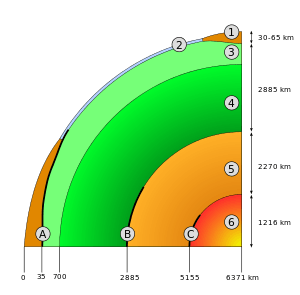Core–mantle boundary
The core–mantle boundary (CMB in the parlance of solid earth geophysicists) of the Earth lies between the planet's silicate mantle and its liquid iron-nickel outer core. This boundary is located at approximately 2891 km (1796 mi) depth beneath the Earth's surface. The boundary is observed via the discontinuity in seismic wave velocities at that depth due to the differences between the acoustic impedances of the solid mantle and the molten outer core. P-wave velocities are much slower in the outer core than in the deep mantle while S-waves do not exist at all in the liquid portion of the core. Recent evidence suggests a distinct boundary layer directly above the CMB possibly made of a novel phase of the basic perovskite mineralogy of the deep mantle named post-perovskite. Seismic tomography studies have shown significant irregularities within the boundary zone and appear to be dominated by the African and Pacific large low-shear-velocity provinces (LLSVPs).[1]

1. continental crust
2. oceanic crust
3. upper mantle
4. lower mantle
5. outer core
6. inner core
A: Mohorovičić discontinuity
B: core–mantle boundary
C: outer core–inner core boundary
The uppermost section of the outer core is thought to be about 500–1,800 K hotter than the overlying mantle, creating a thermal boundary layer.[2] The boundary is thought to harbor topography, much like Earth's surface, that is supported by solid-state convection within the overlying mantle. Variations in the thermal properties of the core-mantle boundary may affect how the outer core's iron-rich fluids flow, which are ultimately responsible for Earth's magnetic field.
See also
- Core-mantle differentiation
- Mantle convection
- Ultra low velocity zone
References
- Lekic, V.; Cottaar, S.; Dziewonski, A. & Romanowicz, B. (2012). "Cluster analysis of global lower mantle". Earth and Planetary Science Letters. 357-358 (1–3): 68–77. Bibcode:2012E&PSL.357...68L. doi:10.1016/j.epsl.2012.09.014.
- Lay, Thorne; Hernlund, John; Buffett, Bruce A. (2008). "Core–mantle boundary heat flow". Nature Geoscience. 1 (1): 25–32. Bibcode:2008NatGe...1...25L. doi:10.1038/ngeo.2007.44. ISSN 1752-0894.
- WR Peltier (2007). "Mantle Dynamics and the D" Layer: Impacts of the Post Perovskite Phase". In Kei Hirose; John Brodholt; Thome Lay; David Yuen (eds.). Post-Perovskite: The Last Mantle Phase Transition (PDF). Volume 174 in AGU Geophysical Monographs. American Geophysical Union. pp. 217–227. ISBN 978-0-87590-439-9.
- Czechowski L. (1993) Geodesy and Physics of the Earth pp 392-395, The Origin of Hotspots and The D” Layer
- Torsvik, Trond H.; Smethurst, Mark A.; Burke, Kevin; Steinberger, Bernhard (2006). "Large igneous provinces generated from the margins of the large low-velocity provinces in the deep mantle". Geophysical Journal International. 167 (3): 1447–1460. Bibcode:2006GeoJI.167.1447T. doi:10.1111/j.1365-
- Dziewonski, Adam M.; Anderson, Don L. (1981-06-01). "Preliminary reference Earth model". Physics of the Earth and Planetary Interiors. 25 (4): 297–356. Bibcode:1981PEPI...25..297D. doi:10.1016/0031-9201(81)90046-7. ISSN 0031-9201.
- Schmerr, N. (2012-03-22). "The Gutenberg Discontinuity: Melt at the Lithosphere-Asthenosphere Boundary". Science. 335 (6075): 1480–1483. Bibcode:2012Sci...335.1480S. doi:10.1126/science.1215433. ISSN 0036-8075. PMID 22442480.
External links
- Earth's Core–Mantle Boundary Has Core-Rigidity Zone
- Audrey Slesinger (January 2001), "Earth's interior: Redefining the Core–Mantle Boundary", Geotimes, The American Geological Institute, retrieved 2011-03-24
- Mineral phase change at the boundary
- Superplumes at the boundary
- About.com article on the name of D″